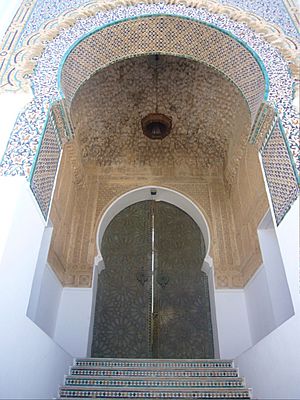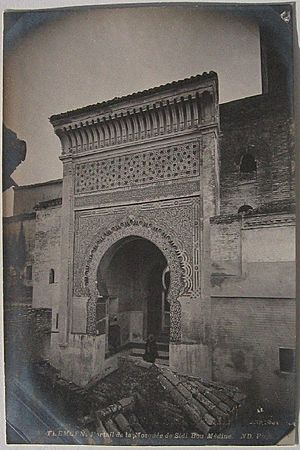Abu Madyan facts for kids
Quick facts for kids Abu Madyanأبو مدين |
|
|---|---|

Entrance of Sidi Boumediene Mosque in Tlemcen
|
|
| Religion | Islam |
| Denomination | Sunni |
| Alma mater | Córdoba al-Qarawiyyin Béjaïa |
| Personal | |
| Born | Shu'ayb ibn al-Hussein شعيب أبو مدين 1126 Cantillana, al-Andalus, Almoravid empire |
| Died | 1198 near the river of Ysser, outskirts of Tlemcen, Almohad empire |
| Resting place | Sidi Boumediene Mausoleum |
| Senior posting | |
| Title | al-Ghawth (The succour) الغوث |
| Influenced | Ibn Arabi Abu Mohamed Salih Abu Said al-Baji Abdasalam Ibn Mashish Abu Abdallah ibn Harzihim |
Abu Madyan Shuʿayb ibn al-Husayn al-Ansari al-Andalusi (Arabic: ابو مدين شعيب بن الحسين الأنصاري الأندلسي), often called Abu Madyan, was a very important Islamic spiritual teacher. He was a great Sufi master from al-Andalus (modern-day Spain and Portugal). Born around 1126 CE, he passed away in 1198 CE.
Many people consider him a key figure in Sufism in North Africa. He was a pioneer in this spiritual path. Abu Madyan taught people to look deep inside themselves. He showed them how to connect their inner feelings with their outward actions. This was often done through a simple, disciplined lifestyle.
Contents
Life Story of Abu Madyan
Abu Madyan was born in 1126 in Cantillana. This small town is about 35 kilometers from Seville. His family was not well-known and they were poor. As he grew up, he learned to be a weaver, which was a common job then.
However, Abu Madyan loved learning. He became very interested in the Qur'an and religious studies. He also wanted to learn about mysticism, a deeper spiritual understanding.
Early Travels and Studies
Abu Madyan left his hometown and crossed the Strait of Gibraltar. He worked for a while with fishermen in Sabta (now Ceuta). After that, he went to Marrakesh. There, he served in the Almoravid army, helping to defend the city.
Soon, Abu Madyan traveled to Fez to continue his education. He arrived in Fez around the time the Almoravid rule was ending. He also saw the start of the Almohad state. In Fez, he studied with important teachers. These included Abu Ya’azza al-Hazmiri and ‘Ali Hirzihim. He also learned from al-Dakkak.
Al-Dakkak gave him the khirka. This is a special cloak passed from a Sufi master to a student. Abu Madyan was especially drawn to mysticism by Sidi Ali Ibn Harazem. After finishing his studies in Fez, he traveled to the East. During this journey, he learned about the works of Al-Ghazali. Al-Ghazali was a very famous Islamic scholar and mystic.
Spiritual Training and Fame
Abu Madyan went to Mecca, a holy city for Muslims. There, he met the great Muslim saint, Jilani. He completed his spiritual training with Jilani. When he returned, he went to the town of Béjaïa. In Béjaïa, he lived a very strict and simple life. He became well-known for his deep knowledge.
People traveled from far away to hear his public talks. They also came to ask him for advice. Many people believed he could even perform miracles. His growing fame worried the Almohad rulers. They were concerned about his influence.
Later Life and Legacy
Eventually, Abu Madyan settled in Béjaïa. He set up a mosque-school there, called a zawiya. His great fame and influence caused concern for the political leaders. The Almohad Caliph Ya’qub al-Mansur asked Abu Madyan to come to Marrakech. The Caliph wanted to speak with him directly.
On his journey to Marrakech, Abu Madyan became ill. He passed away in 1198 CE, near the Ysser river. His last words were said to be "Allah al-Haqq" (God is the Truth). He was buried in al-‘Ubbad, near Tlemcen, Algeria. His funeral was a very important event for the people of Tlemcen. Since then, he has been seen as the patron saint and protector of Tlemcen.
A special tomb, called a mausoleum, was built for him. It was ordered by the Almohad ruler, Muhammad al-Nasir. Many princes and kings of Tlemcen have added to this mausoleum over the years. In the 14th century, the Marinid kings built many beautiful buildings near his tomb. These include the Mosque of Madrasa. His tomb is still a place of pilgrimage for many Sufis today.
Abu Madyan's Teachings
Abu Madyan's school in Bejaia taught important principles. These included:
- Tawba (repentance): Turning away from bad actions.
- Zuhd (asceticism): Living a simple life without too many worldly things.
- Visiting other spiritual masters to learn from them.
- Serving experienced teachers.
He also stressed futuwa, which means youthfulness or chivalry. This included being obedient to one's master. It also meant avoiding arguments and being fair. He taught people to be constant, noble, and to speak out against injustice. He encouraged a feeling of happiness with God's gifts.
Abu Madyan and his followers believed in accepting their emotions. They did not just focus on simple living and meditation. Instead, they lived daily lives and kept close relationships with people around them. Abu Madyan shared his knowledge with his students. He also wrote many poems and spoke in proverbs. This helped him connect with everyone, not just scholars.
A historian named Yahya B. Khaldun said that Abu Madyan's teachings can be summed up in one verse. He often repeated it: "Say Allah! and abandon all that is matter, or is connected with it, if though desirest to attain the truth goal."
His Lasting Legacy
Abu Madyan achieved a high spiritual status called Ghawth. He also taught hundreds of students. But his influence went even further. He became very popular because people could relate to him. Even though he was a great scholar, he had a way of speaking that brought people together. He connected with everyone, from ordinary people to academics.
Even today, scholars say that no one in his time had more religious and intellectual influence. His school produced many saints. Out of 46 Sufi saints in the Rif region, 15 were his students. People still visit his tomb today. They come from all over the world to pray and seek blessings through him.
Writings and Sayings
Not many of Abu Madyan's writings have survived. The ones that do exist include mystical poems. There is also a testament (wasiyya) and a creed (akida). He encouraged people to express their emotions freely. However, he also supported a simple lifestyle and full devotion to God.
Works
- Bidayat al Mouridin, a manuscript found in Algiers.
- Diwan, a collection of his poems published in Damascus.
- Ouns al Wahid, a work with a commentary by Ahmed Bâ'chan.
- Tahfat al Arib, translated into Latin by F. de Dombay.
- The Way of Abu Madyan, a bilingual collection translated by Vincent Cornell.
- Adab al-Murid, a poem about how students should behave on their spiritual journey.
See also
 In Spanish: Abu Madyan para niños
In Spanish: Abu Madyan para niños



